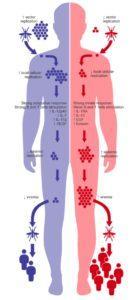
Source: Pinheiro et al., 2018 (PloS Neg. Dis): Proposed model for L6 lineage (red) dominant circulation without L1 lineage replacement (blue) in the SJRP population, with the main differences found between the two DENV-1 lineages.
Circulation of Dengue virus (DENV) infections is characterised by frequent lineage turnover, where a circulating strain is usually replaced by a new lineage. This phenomena is known as clade replacement, can lead to an increase in cases and severity of DENV disease.
Between 2008 and 2015 epidemiology of the circulating strains of DENV-1 in São José do Rio Preto (SJRP), São Paulo, Brazil. Surprisingly the introduction of a new lineage L1 in 2010 did not result in clade replacement of the circulating L6 lineage. By 2013 L1 ceased to circulate and L6 reestablished itself as the dominant circulating strain. A study conducted in Brazil aimed to understand the role of viral fitness and immune responses in the persistence of L6, despite the introduction of L1.
The study showed that L1 viruses had higher replicative fitness than L6 virus in vitro (non-human primate and human) cell lines and mosquitoes. This suggested an advantage of transmission and replication of L1 virus over L6 virus. Immunological analysis of samples from DENV-1 L1 and L6 infected individuals, showed that neither of the strains preferentially inhibited type-I interferon responses. However, analysis of cytokine expression profile demonstrated that the L6 virus induced stronger anti-inflammatory (IL-1RA, IL-13) and Th2- like (IL-13, CCL11) responses, where as L1 virus induced a pro-inflammatory (IL-12p40, Il-17a) responses associated with resistance to dengue infection. Additionally, they showed that L1 virus was more immunogenic, characterised by increased B and T cell activation, than L6 virus in a murine model.
In summary, this study demonstrated the interplay between viral replicative, immunological and epidemiological features in the spread of DENV. The study proposed a model for the inability of L1 virus to replace L6 virus. Where, despite L1 virus having superior viral fitness than L6, the increased viral replication induces stronger immune responses that prevent systemic replication and resulting in lower viremia. As a result, less L1 virus will be spread from humans to mosquitoes compared to the less immunogenic L6 virus which results increased systemic replication and higher viremia.
Article: Pinheiro et al., 2018. Viral immunogenicity determines epidemiological fitness in a cohort of DENV-1 infection in Brazil. PLoS Neglected Tropical Diseases.
Article by Cheleka AM Mpande.










